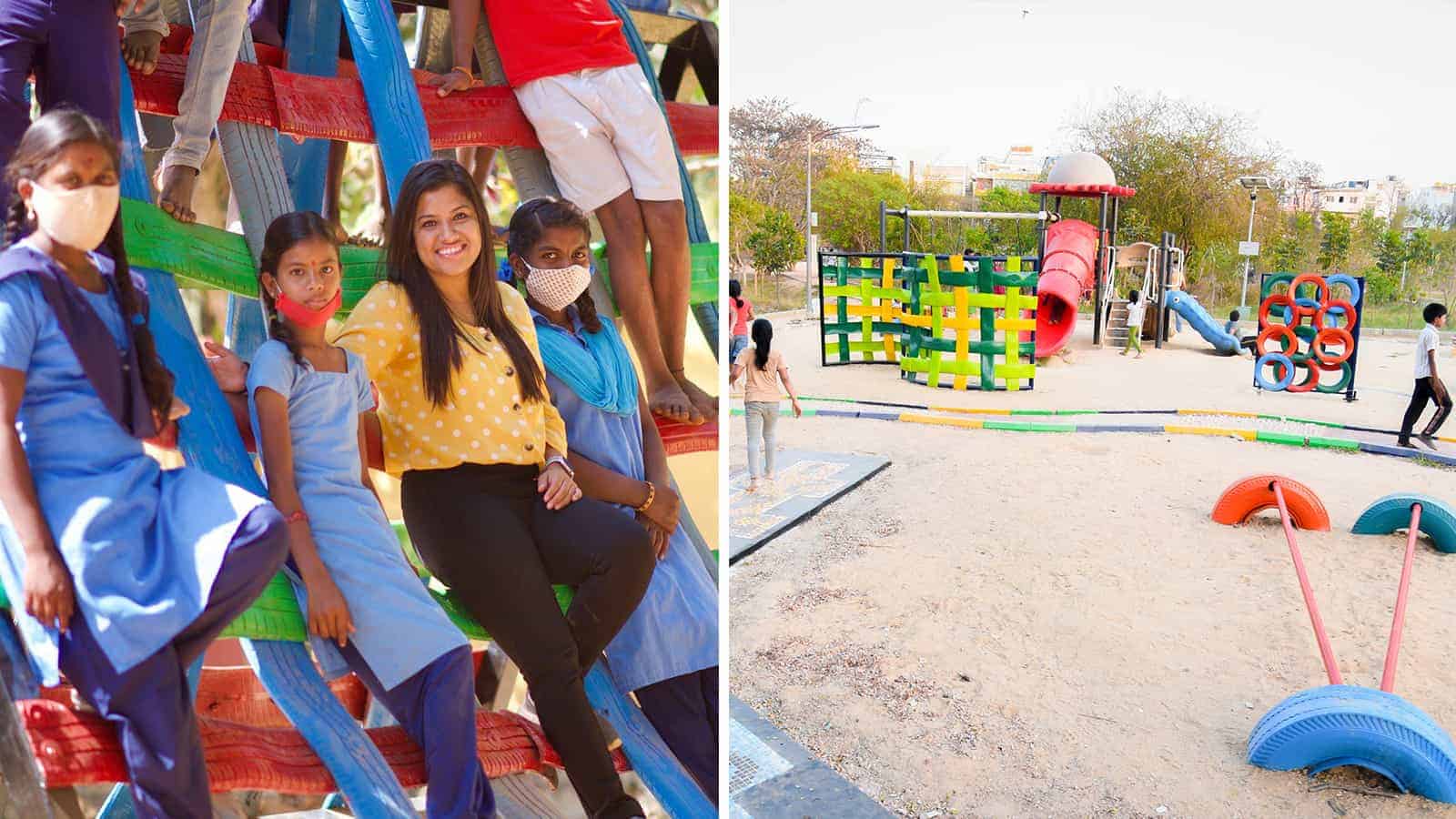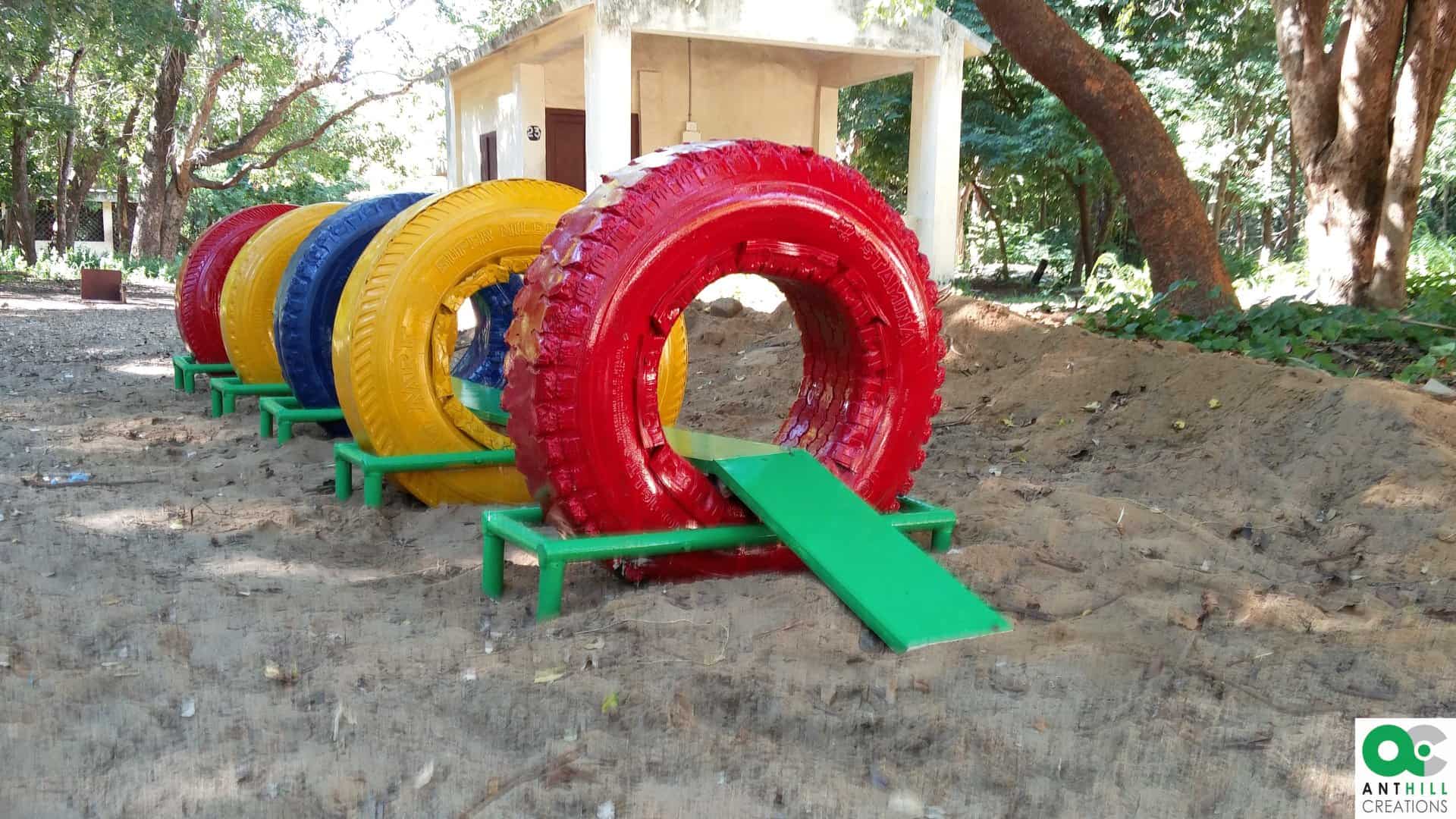In the old days, you’d see kids having fun on the playground at school. Nowadays, that sight is becoming increasingly rare, unfortunately, but one woman in India is determined to change this. Young architect Pooja Rai designs safe, colorful playgrounds in Bengaluru, Karnataka, India. She uses discarded tires to create cheap, durable play areas for kids of all ages to enjoy.
Since 100 million tires get thrown away in India each year, she has plenty of materials to work with. Schools that need playgrounds complete with engaging thermoplastic markings contact Rai for a unique tire playscape. So far, she’s built 283 different play areas made almost solely of painted tires.
Because of her passion for giving kids safe places to play, she decided to start Anthill Creations. The non-profit “aims to bring back play for all age groups by building sustainable playscapes.” It utilizes local resources and encourages communities to come together again through play.
Rai believes that every child deserves the right to play in a safe, interactive environment. However, many play areas have become rundown due to lack of use. Unfortunately, recess and playtime have largely disappeared from most schools in India because of academic pressure. Teachers have more on their plates due to standardized testing, so students must spend more time learning.
This may help students pass their exams, but their physical health suffers. More children than ever before get diagnosed with ADHD, and some experts believe lack of exercise is to blame. Rai hopes that the innovative playgrounds she helps design will encourage teachers to reconsider playtime.
“We live in a world where play, such an essential part of growing up, is now viewed as a luxury and even thought of as unnecessary,” Rai said in an interview with Christian Science Monitor.
The playgrounds help renew kids’ playful spirits.
The lockdowns during the past year took a toll on children in India. The school principal in a small village began to worry about attendance because of high poverty in the area. Many parents had encouraged their kids to take jobs at local packaging industries to earn extra income.
The future of the school looked bleak until they enlisted the help of Ms. Rai. The school thought that redesigning their playground would spark kids’ interest again, bringing attendance back up. The school gathered funds for the play area, and a local bank even agreed to donate to the cause. The new playspace contains two tire swings and a motorcycle; it isn’t much, but the kids love it.
Second-grader Srilekha Murlikrishnan says she loves the blue tire swing even better than a regular swing. “I’m more flexible and can twist my body through the hole,” she says. “I come to school now just to play here every day, and I’m really looking forward to it reopening again.”
Rai says that the lack of public playgrounds for children in India greatly inspires her vision. In fact, she saw firsthand the need for more play areas during her college years. She went with a friend to a local orphanage one day and saw children playing with dangerous objects.
“Kids were playing with anything they could get their hands on,” she says. One group played with a broken metallic pipe and even started swinging it around like a sword. Two boys used their flip-flops as rackets to play badminton. Even though the kids seemed happy, Ms. Rai felt like they deserved better. “Play shouldn’t just be part of a rich, privileged kid’s lifestyle. All kids have a right to enjoy their childhoods,” she says.
A lack of adequate playgrounds in India inspired Anthill Creations
A few weeks after the visit to the orphanage, Rai started formulating a plan. She talked with friends about raising money to build affordable playgrounds; however, she wondered how to go about it. One day, she got the idea to use old tires as play equipment. After all, so many got thrown away, so why not put them to good use?
In 2015, they built the first playground using dozens of recycled tires, all inspected for safety and painted vibrant colors. The next year, Anthill was born, and they’ve since built almost 300 play areas with the help of 800 volunteers. Most of the playgrounds the company creates have classic components like swings, jungle gyms, and seesaws. They also build fun, unique tire sculptures such as cars, buildings, or animals, making the play areas inviting for children.
The team starts a project by gathering tires, which are cleaned and examined for safety hazards. Then, they paint them various bright colors and drill holes to keep rainwater from accumulating inside. Rai makes sure to meet with the kids to find out what they want in a playground.
After getting all the materials and design ideas ready, they worked on a budget. A small playground costs around $800, and larger ones can be up to four times as expensive.
However, the non-profit gets help from generous donors who sponsor most of the play areas. India is the first country to require corporations to donate some of their earnings to charity. So, Anthill helps schools connect with corporate fundraising partners for help with a playground.
Where they install play equipment for children
They construct the playgrounds in schools as well as public parks and refugee camps. The volunteers get creative with the designs, creating animals and even ships out of the tires.
One girl’s school in Bengaluru even wanted a boxing ring and punching bags made of tires. While their teacher worried about them getting hurt, the girls insisted they wanted the space to practice self-defense. In December 2019, the unique request for a playground came to life.
Final thoughts on how a woman in India creates playgrounds for kids using old tires
The playgrounds that Rai and her team have created help brighten up the environments and lives of children. They envisioned an affordable, safe way to build play areas so that kids could enjoy their youth. This vision became a reality, and thousands of kids have benefited from the charitable organization.
“We often forget how vulnerable these growing years can be,” Rai told CSM. “The right to play should be considered critical to a child’s cognitive growth, physical, and emotional well-being—we believe that it is indeed a basic human right.”



















